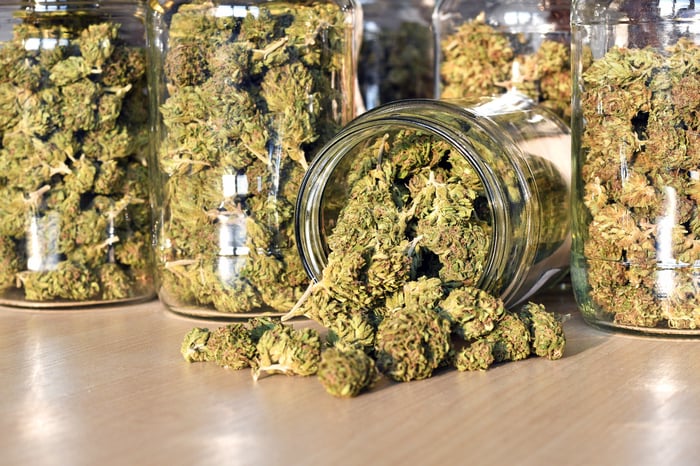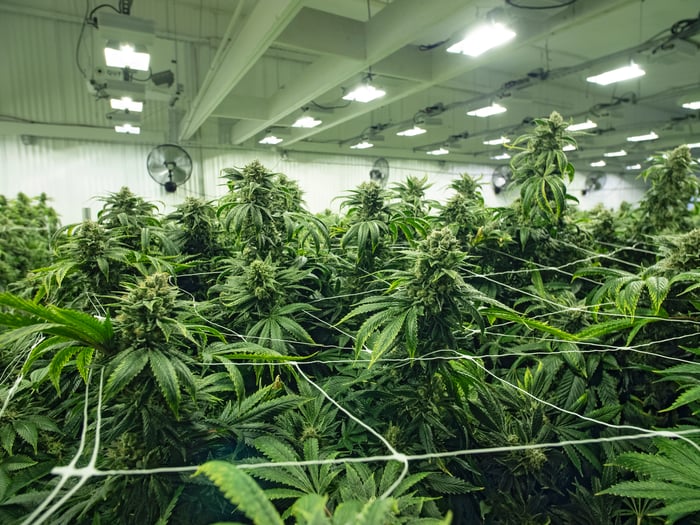To say that marijuana stocks have been volatile would be a bit of an understatement. Last year, more than a dozen pot stocks wound up gaining in excess of 70% during the first quarter. But the final nine months of 2019 were marked by a steep downtrend in cannabis stocks, resulting in most finishing the year far lower than where they began.
Visions of rapid sales growth and profitability quickly faded and gave way to the realities that supply is constrained in Canada, tax rates on pot are far too high in most recreationally legal U.S. states, and the black market remains resilient. This has caused a number of marijuana growers to rethink their production needs, including the most popular marijuana stock in the world, Aurora Cannabis (ACB -3.66%).

Image source: Getty Images.
Aurora Cannabis is no longer a marijuana production kingpin
By midyear 2019, Aurora Cannabis was projected to be the largest producer of weed, when at full operating capacity. The company had 15 cultivation facilities that were expected to generate no less than 625,000 combined kilos of annual run-rate capacity by the end of its fiscal 2020 (June 30, 2020), with peak production potential of around 670,000 kilos. Such a huge annual haul of marijuana was expected to make Aurora a popular grower to forge supply deals with, as well as push its per-gram production costs well below the industry average.
But industry dynamics in Canada have coerced changes from growers both big and small. Ontario's inability to open a sufficient number of cannabis retail locations, and Health Canada delaying the launch of derivatives by two months, have hurt pot stock operating results and sent many growers into cash-conservation mode, including Aurora.
In recent months, Aurora Cannabis announced that it would be halting construction on its 1-million-square-foot Aurora Nordic 2 facility in Denmark, which was slated to produce at least 120,000 kilos per year, as well as its 1.62-million-square-foot Aurora Sun campus in Alberta. Only six grow rooms covering 238,000 square feet at Aurora Sun will remain in use for the time being. Aurora Sun was expected to produce at least 230,000 kilos annually at full capacity. These two construction halts essentially removed around 320,000 kilos of run-rate peak annual output.
What's more, Aurora recently announced that it was putting the Exeter facility up for sale. Exeter is a 1-million-square-foot vegetable-growing greenhouse on 164 acres that was acquired as part of its buyout of MedReleaf for 2.64 billion in Canadian dollars ($2.02 billion). The idea had been that Exeter would be retrofit to produce no less than 105,000 kilos of cannabis per year; but Aurora simply never got around to this project. Assuming this sale goes through, Aurora Cannabis will have sold or set aside roughly 425,000 kilos in annual output, potentially reducing its yearly run-rate production to less than 250,000 kilos.

Image source: Getty Images.
These cannabis stocks may outproduce Aurora
Meanwhile, three growers might be able to outproduce Aurora Cannabis, assuming Aurora Sun and Aurora Nordic 2 remain on ice.
First, there's Canopy Growth (CGC 0.45%), the largest marijuana stock by market cap. Canopy Growth has 10 production facilities, and the company has yet to announce any intentions to cut back on its output. Then again, it hasn't exactly been forthcoming with its peak production estimate, so it's a little bit of a guessing game. With Canopy projected to have 5.6 million square feet of cultivation space, north of 500,000 kilos is the current expectation. We should learn a lot more in the months to come as new CEO David Klein outlines the company's strategic growth objectives.
Second, Aphria (APHA) has a decent shot at outpacing Aurora Cannabis in production. Following a more than 18-month wait, Health Canada approved the joint venture Aphria Diamond farm for cultivation in November. This farm is capable of 140,000 kilos of peak annual cannabis output, which goes along with 110,000 kilos for Aphria One, and 5,000 kilos for Broken Coast Cannabis (which Aphria acquired). All told, Aphria's 255,000 kilos of peak run-rate output might edge out Aurora Cannabis.
Third and finally, Flowr (FLWPF) might be a dark-horse candidate to deliver more marijuana than Aurora Cannabis (albeit that's unlikely to happen in 2020). In Canada, Flowr is primarily focused on its Kelowna campus in British Columbia, which will be capable of roughly 50,000 kilos of premium and ultra-premium weed. However, Flowr also acquired the remainder of Holigen that it didn't already own last year, thereby inheriting the 7-million-square-foot outdoor Aljustrel grow farm in Portugal. This farm is capable of as much as 500,000 kilos a year in run-rate output when at full capacity.

Image source: Getty Images.
Aurora has bigger things to worry about
When push comes to shove, Aurora Cannabis has far more important things to worry about than being the top producer of marijuana in the world.
For one, there are glaring concerns from a few analysts on and off Wall Street that Aurora may not have enough cash on hand to make good on its debts. The company already had to amend a CA$230 million convertible note that was slated to come due in March by issuing a boatload of new stock, and has $400 million (that's U.S. dollars) in additional at-the-market share offerings at its disposal to bolster its cash position. Halting construction at two of its largest grow farms (Aurora Sun and Aurora Nordic 2), as well as cutting ties with Exeter, are all a means to conserve cash and reduce operating expenses in the meantime.
In addition to bolstering its cash, Aurora is likely going to need to deal with the mammoth amount of goodwill on its balance sheet. After grossly overpaying for more than a dozen acquisitions over the past three-plus years, Aurora's CA$3.17 billion in goodwill now accounts for a staggering 57% of its total assets. The sooner Aurora admits that it overpaid for previous acquisitions and writes down a significant portion of this value, the better the company's balance sheet will look.
Aurora Cannabis has a lot of work ahead of it, and the company that investors see today looks nothing like what was envisioned as recently as six months ago.





